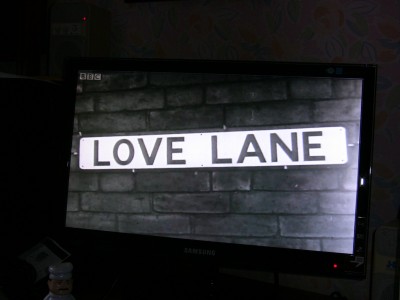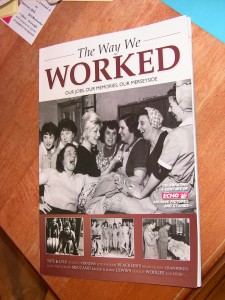Love Lane Lives
The history of sugar in Liverpool and the effects of the closure of the Tate & Lyle sugar refinery, Love Lane
Love Lane’s Memory Lane
Written by Ron Noon at 05:12 on Friday, November 26th 2010
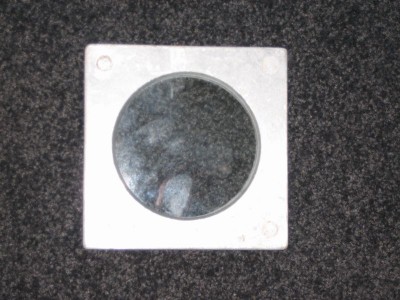
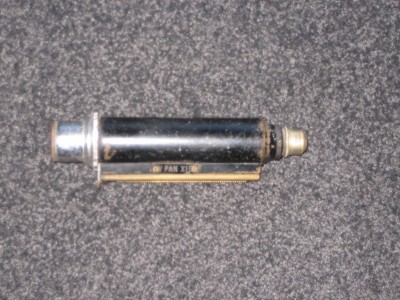
“It was a hot August day and I remember being on the Sweetland Press floor in the heat and the humidity and thinking how bad the smell was. It made me feel ill and I didn’t think I would be able to stand it. After about a day or so I ceased to notice it. How strange that we easily get used to things.”
That is an extract from the account that Mike Greenall provided of his early days as a Process apprentice in Liverpool’s historic Love Lane where working conditions were clearly at variance with the refinery’s romantically sounding name! After he left school in July 1965 Mike started his apprenticeship in the refinery where he would be mentored by pansmen like Bobby Austin. In the so called “post industrial” era the term “apprenticeship” has sometimes seemed a misnomer for what skilled workers like Mike and many others like him regarded as a real and rewarding technical education. His apprenticeship was designed to provide training for “young men” in all aspects of the processing of sugar from the raw, which was ferried by wagon from the Huskisson dock, to the various refined products that Tates were famous for. Mike has informed me that the ultimate goal of the course was to train people to be the next generation of Pansmen, Chargehands and Foremen.
I’ve made reference many times in these blogs to the fact that sugar is not as many of its vested interests would claim NATURAL and certainly there have been no sightings of sugar crystals growing on mother nature’s plants in recent times even in this era of genetically modified crops. Therefore the making of SUGAR is very much man made and industrial, an essentially purging,and laundering process in highly “chemicalised” refineries or as W.A. Aykroyd called them “Temples of Applied Science”. There is a great deal of skill involved in the processes and methods deployed and I’m going to reproduce an account from a SUGAR book published in 1949 and edited by Anthony Hugill.
“The boiling of sugar is the work of an expert, and under present conditions, it takes three years for a panman to reach full proficiency. The degree of proficiency required and the size and type of pan used depend very much on the grade of sugar which it is desired to boil. In the majority of cases the aim of the panman is to boil a pan of sugar without making ‘false grain.’ The usual method is to draw into the pan a small charge of liquor, and boil it until it reaches the correct degree of super-saturation, which it is part of the panman’s skill to determine. The thickened charge is then seeded with a little caster or icing sugar which brings out a large number of ‘points’ or tiny crystals. This process is known as ‘graining’ and is followed by the addition of more liquor. After graining the object is to continue boiling with the gradual addition of more liquor until the pan is full, in such a way that the original ‘points’ grow until they are of the right size. The appearance of any further points at a later stage in the boiling is known as ‘false grain’ and must be avoided as it will spoil the regularity of the ultimate sugar…In the boiling of small crystals such as granulated sugar, an experienced man will in most cases accomplish his object and turn out a pan of sugar of fairly regular size crystals.” Pp.s 35.36.
This was the world that 16 years later Mike entered and there is already a blog of Mike’s experiences dated June 10th 2009 on our site. Readers may be interested to update themselves with this because what I’ve reproduced below is PART TWO of his apprenticeship days! P2 was sent to me earlier on this year and I’m hoping for P3, P4… One consistent theme it seems will be Mike’s fondness for tea drinking, a good cuppa char, which on a Love Lane Lives website is a fact that perhaps I’ve taken too much for granted! More about TEA after this:
“Hi Ron, here is a bit more of what I remember of my time at Tates…Some of it might be incorrect, but I’m sure there are people you know who can correct any errors!
As new Apprentices our first port of call after our induction was two weeks with Huskisson Transit Co. This was the sugar berth at Huskisson Dock and the 100,000 ton silo across the road, now virtually derelict, though still in existence. During our time there we spent time on the ships watching the unloading process, though we were not allowed to take notes whilst on the dock or the ships in case we upset the Dockers, as if they thought we were writing anything down, they were quite likely to walk off the job!
Modern Health and Safety would not be impressed as to how we got to the docks. We would make our way round to the raw sugar unloading bay on Vauxhall Road and scrounge a lift off one of the drivers hauling the sugar up from the dock, one of us would sit on the passenger seat and the other would perch on the engine casing in the cab. The operation of the dock and silo was fairly straight forward. The ships hold would be opened up and the cranes would commence unloading the contents which was in bulk and unloaded using grabs. The crane then swung round to deposit its load into a hopper which fed onto a conveyor system. I think there were four cranes to each berth. The conveyors fed up over the Dock Road and into the top of the silo control tower, in which was the control room, from which the operation of the conveyors in and out of the silo was controlled. The sugar was then fed by another conveyor system, up and along the top of the silo in an enclosed tunnel, this conveyor fed onto a shuttle band which moved on a railway track up and down the length of the silo, evenly depositing the sugar inside. It was quite impressive to stand in the silo and watch the sugar cascading down from the roof to form big mountains on the floor of the building.
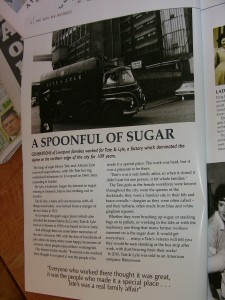
Great pictures from a Liverpool Echo book on WORK. Who are the blue turbanned ladies?
The sugar was withdrawn from the silo by means of an underground conveyor system. The sugar was allowed to feed onto this conveyor by a system of louvres which, when opened, allowed sugar from whichever part of the silo was required, to feed onto this band. It was then conveyed up into the tower where it was weighed in Servo Balans weighers for Customs purposes, that is, to calculate the tax to be paid, before being fed into the delivery hoppers. The bulk sugar wagons would pull up under the hoppers to be filled and weighed then make their way up to the factory, usually with small boys hanging onto the back! If the driver saw them, he would stop and chase them, but by the time he got in the cab and got moving, the boys would be hanging on the trailer again!
The wagons would park up in Burlington Street alongside 149 shed, which was another raw sugar storage facility, rather like the dock silo in use though a lot smaller and looking from the outside like a large warehouse type shed. While they waited, the drivers would spend their time polishing their Cabs; they were quite proud of their appearance and always had clean tractor units. As they were required, they would pull round to the raw sugar intake to unload. The Wagon would pull into the unloading bays. On each side of the vehicle set into the ground and running the length of the trailer were heavy metal grills covering large hoppers. The trailers were divided into two open topped compartments, inside each compartment was a V shaped centre section, which caused the sugar to run out when the compartment was opened. Along the bottom of the compartments on both sides, was a compressed air operated door, rather like the tailgate of a tipper truck. The plant operator would hook up a compressed air line to the rear of the trailer and open the doors to allow the sugar to run under gravity into the hoppers set into the ground. In a matter of seconds the trailer would be empty, the doors would be closed, again by the use of compressed air, and the wagon would be on its way back to the dock for another load. As it left, the next vehicle would be on its way in to discharge its load.
Beneath the Hoppers was a system of conveyors which carried the sugar from the Intake up into 149 shed and along the upper part of the shed wall alongside Burlington Street, up a bridge over the canal, to the Raw Sugar Silos. Inside 149 Shed were a couple of machines built on the gantry carrying the conveyor called Throwers. These machines were used to literally throw sugar into the shed for storage, the sugar would be shot out of these machines up to the roof of the shed where it would hit baffle boards then it would fall back to form large mountains of sugar on the shed floor. This sugar was used in the event of a stoppage in the flow of sugar from the docks. The shed held approximately 10,000 tons.
There were four Raw Sugar Silos which were filled up during the course of the day so that by five oclock, when the drivers knocked off, there would be enough sugar stockpiled to keep the refinery going till they started hauling sugar again the next day. The sugar left the Silos via a system of louvers feeding onto steel bands which in turn fed onto a conveyor up another bridge, over Burlington Street this time, it passed over a Band Weigher which recorded how much sugar was going into the refinery and then entered the Melt House to begin the process.
We spent a few weeks with the Plant Operators learning the running of the Intake and the Raw Sugar Silos, though I have to admit a lot of the time was spent in the Rest Room drinking tea!”
................................................................
Whoops! I seem to have encountered another technical glitch because I just tried to upload the piece I’ve put together on TEA and also the two pictures that Mike sent me. Right in the centre of this screen appeared the message: “This operation has been cancelled due to restrictions in effect on this computer. Please contact your system administrator.”
I don’t know who that is!!! All I know is that I’m in a lovely old public library in snowy Sunderland which I’ve been using all this week since my wife and I rushed up Cannyland last Friday afternoon to attend to the needs of my wife’s mum who went into hospital that day. She’s on the mend which is great news but I’ve only been able to function on the web, because of Kayll Road public library which is right opposite Sunderland Royal Hospital. Now it seems even these invaluable institutions are subject to even more Government cuts and have glitches similar to those experienced in my study or University Library back home in Liverpool. I’m getting kicked out in ten minutes because the library is going to close! (I queued outside of it at 9.25 yesterday morning before the snow began to fall and only realised a quarter of an hour later that it was closed on a Thursday. Boy did I experience withdrawl symptoms not gaining access to the web and my sugar files!) Anyway I’ll just upload what I’ve already written and come back later after this afternoon’s hospital visiting time.
TO BE CONTINUED
Here I am back in Kaylle Road which was the library my wife used when she was a child, and I’ve now had the technical problem resolved and so hopefully the pictures that Mike gave me are reproduced both in the summary of this blog and also in the main body of the text.
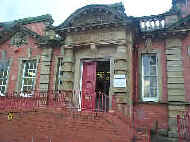
What was I “saying” about TEA?
“The first sweetened cup of hot tea to be drunk by an Englishman was a significant historical event, because it pre-figured the transformation of an entire society, a total remaking of its economic and social basis.” That’s a lapidary comment by Sidney Mintz, the doyen of sugar studies, in his seminal book Sweetness and Power. (1985) Outside my circle of sugar centrics this loaded argument would perhaps be difficult to grasp. It was for me initially but it is in fact key to understanding how this now taken for granted everyday commodity revolutionized the modern world. Mintz, without using the term “Sugar Revolution” used by Australian writer Higman, urges readers to “struggle to understand fully the consequences” of precisely that phenomenon and “other kindred events” of early modernity, “for upon them was erected an entirely different conception of the relationship between producers and consumers, of the meaning of work, of the definition of self, of the nature of things.”
Sugar, just like the G word, globalisation, (is it an s or a z?) has come from nowhere to be everywhere and its ubiquity provides a great example of how a taken for granted everyday commodity has a complicated social history, that provides good insight into the drivers that still operate in the world economy today. Sugar is a great example of an intensely political product that links the story of agriculture and agribusiness from the days of the plantation and the yoking together of field and mill, to the inexorable logic of world food markets today.
But where would sugar be without tea? Reflect on this extract which I’ve taken from an Open University Social Science Foundation year text which I taught back in the early 1990s. It relates to FOOD FOR THOUGHT.
“Tea was first developed in China, where it was called ch’a (from where we derive our own word ‘char’). In AD 805 a mandarin, Lu Wo, wrote The Cha Ching (The Book of Tea) and by that time tea was part of the internal Chinese tax and finance system. By 1200 it was a major item in commerce between provinces and by 1400, Hunan Farmers had begun to specialise in its production. It was still unknown in Europe.” It was not until the 1650s that tea was brought to Britain and it did not catch on at first. It was only when Charles II married the Portuguese Princess Catherine of Braganza, that things began to change. (1662) “She arrived with her dowry, which was Bombay and Tangier…and her tea-chests. The king neglected her and she found solace in tea. As a bribe, the directors of the East India Company gave her regular presents of tea; the Court ladies imitated her, and the taste for tea spread to bourgeoisie housewives like Mrs Pepys and thousands like her. However at 50 shillings a pound, tea did not spread far beyond the Court: tea drinking and brewing became a high status ceremonial which only the richest and most refined ladies, allegedly understood. Throughout the eighteenth century, the cost of tea fell and the taste for it spread. The bourgeoisie was soon commenting on the habits of tea drinking servants, who aped their betters.”
Rowling, N., 1987, Commodities: How the world was taken to market
People did not always crave sugar. For that to happen Roberts a recent writer on Globalisation argues “a luxury had to be converted into a necessity, a taste had to be created”. The taste for sweetened tea and other exotic tropical luxuries was rapidly acquired and what had been a luxury only indulged in by the rich and privileged, (why were there locks on tea chests?), became an essential part of proletarian diet during the classic industrial revolution era.
As Jim Walvin points out in his beautifully written book Black Ivory “tea brought from the eastern extremity of the world, and sugar brought from the West Indies, and both loaded with the expense of freight and insurance…compose a drink cheaper than beer”. I was tempted last year to use this as an exam question for my final year students on my GLOBALISATION IN HISTORICAL PERSPECTIVE course but for some reason I resisted!
Part of the explanation for this surge in tea consumption (how many think that tea drinking has always been a quintessentially English phenomeon?) was to do with the lowering of the tea duties in 1784. The result was that tea drinking in Scotland became so popular that it dislodged the “local commitment to malt liquor”. The history of sugar as has been painstakingly argued on this site, does not go back to the orgins of the biosphere as some Affiliation Biased Scientists suggest. It’s much more recent phenomenon, (albeit at least 500 years), and it links in with the chronology of capitalism.
That “fact” is an important reminder that globalisation is much more extended in its chronology than the last quarter of the 20th century and the rhetoric used by “extreme globalisers”! There is often too much emphasis on discontinuity and so the story of sugar “capitalism’s favoured child” is a “healthy” reminder of the continuing and recurring themes behind commodity production and production for exchange. The G word demands fitting into a longer historical perspective and the tea phenomenon linked in inextricably to the leavening out of many exotic tropical luxuries with its intense sweetness. Then and now it is a narrative of interconnectedness and to use the buz phrase in academic circles, “time/space compression”, albeit in a different epoch and context to that when the “sailing ships” of Liverpool and Boston moulded the world’s Zeitgiest. James Walvin’s “wee late eighteenth century story” of globalisation and “skeins of interconnectedness” with malt liquor in Scotland “downsized by TEA is a real cracker. It highlights how products from opposite sides of the globe were quaffed down in hot liquid solution in late eighteenth century England. There’s nothing trivial about a tea break Mike!
.........................................................................................................................................................................................................................................................................................
*My debts to Professor Doreen Massey and her social science foundation year course team at the Open University which I was proud to teach on for many years, are gratefully acknowledged. I never realised when I had my own OU tutees on a SATURDAY morning that I would subsequently become addicted to the story of sugar in a much more intense way than was demanded by the course team. But that was down to Albert and John who had nothing whatsover to do with the OU but who would nonetheless have loved the idea of largely mature “second chance to learn students” turning up on a Saturday morning to deepen their knowledge of THAT THING CALLED SOCIETY!
................................
Finally here’s an extract from The Sugar Cane Industry: An Historical geography from its origins to 1914 a book written by J.H. Galloway, University of Toronto.
“The decline in the price of sugar permitted people to assuage their taste for sweetness, but it also had a sombre side. The industrial revolution created a new working class and gave it a new sugar laden diet. Industrialisation drew people from the countryside, from their gardens and fields, woods and streams which had provided their food, to the tenements and back to back houses where they had to buy what they ate. The long hours spent tending looms, mills and other machinery, by women as well as men, meant that there was less time for preparing meals at home. Food had to be cheap, easily served and it was often insufficient. One response of the English working class to this situation was to incorporate into its daily diet many cups of sweet tea, a calorie-laden stimulant that warms the body, revives the spirits and blunts the pangs of hunger but does not nourish. A second response was to abandon the careful cooking of traditional dishes in favour of cold or quickly heated, store bought, factory processed food. The ‘jam buttie’, nothing more than factory made jam spread on a slice of factory made bread, is a sugar rich, high calorie ‘convenience food’, quickly prepared and quickly eaten. Sidney Mintz (1985: 180) has seen a dark side to this transformation of the English diet and has offered the hypothesis ‘that sugar and other drug foods, by provisioning, sating - and, indeed drugging - farm and factory workers, sharply reduced the overall cost of creating and reproducing the metropolitan proletariat’. To one exploited group associated with sugar - the slaves who for so many centuries cultivated the cane - Mintz would now add another: THE CONSUMERS..”
